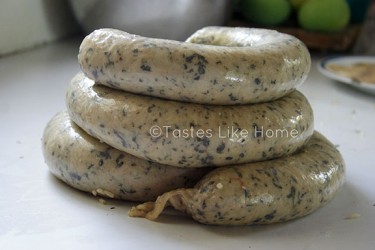Hi Everyone,
This week begins a 2-part series about Black Pudding.
A recipe is someone’s interpretation of how to make a dish. In its simplest form, a recipe is a list of quantified ingredients followed by instructions about how to put together the ingredients. There are very many dishes that can be made by simply following a recipe. However, Black Pudding is not one of those dishes. Black Pudding cannot be made just by being guided by a recipe, rather, it requires an intimate knowledge of cooking and a certain mastery of employing all of one’s senses. Making Black Pudding requires experience and specialized skills. A Black Pudding maker cooks with skills that have been honed since they were very young.
Ask your favourite Black Pudding lady how or where she learnt to make Black Pudding and I will bet you that she will give you a tender to early teenage year. She’ll also most likely tell you that she learnt it by watching (and eventually helping) her grandmother, mother, aunt, elder sister or some older relative who was adept at making Black Pudding. Through theyears, that knowledge has been passed from one generation to the other.
Black Pudding, which is a type of blood pudding, has been around since we humans have farmed and kept livestock to provide food. It is therefore a blood sausage that is well known throughout the world. The influence of our Caribbean Black Pudding most likely came from the British and like so many blood sausages these days, we have adapted it to suit our taste and to capitalize on the use of readily available ingredients.
The making and selling of Black Pudding was and continues to be a constant, reliable source of income for many households. It is a micro business that is built solidly on knowledge of the product, by reputation and by consistently high standards over the years. It is a lesson from which many of us can learn something.
over the years. It is a lesson from which many of us can learn something.
I spent a day a couple of years ago with my friend Gillian who knows how to make Black Pudding – a skill she learnt from her mother and grandmother. I wanted to do behind-the-scenes photography of the process of making Black Pudding so we had arranged to capture it from start to finish. More recently, whilst on my trip to uyana, I got the opportunity to see another Black Pudding-making family (Maurette & Aubrey Walcott and Auntie Mertha) in action as they too busied themselves making Black Pudding (and White Pudding). There is much that I observed and much that I learnt. On both occasions I marvelled at the instinctiveness of their cooking. It was all done with sagacity that had built up over the years of seasoned practice – of learning by doing and learning by observing. Their apprenticeship was over decades ago; I was watching masters at work. It made me think of Sushi chefs who have to apprentice for years in order to learn their craft. I thought to myself jokingly – I could open an eatery that only sells Black Pudding and apply for a work permit to hire a Black Pudding Specialist. What? I’m serious. Making Black Pudding is a specialty. If the work permit gets challenged on the grounds that Barbados has Black Pudding makers, I’d have to have samples made and taken to the immigration review committee so that they can see and taste that it is not the same thing. All right before one of you all report to immigration that I am dissing Bajan pudding, I am not, I like a proper Bajan pudding (steamed sweet potato pudding); I want Guyanese Black Pudding.

Where was I? Oh yes, admiring the work of the women (and man). Working with knowledge that extended through the use of their senses, they could ‘eye’ when the rice was done cooking and they could feel when it was cool enough to be handled. There was no need for them to taste anything as they were progressing with their work because they have been making Black Pudding for so long that they know exactly how much salt and seasonings and herbs have to go into the Black Pudding. Not a measuring cup or spoon was in sight. Again, they ‘eyed’ how much blood was to be mixed into the rice for the Black Pudding and how much milk/coconut milk was to be added to the rice for the White Pudding.
When it came to filling the runners (casings) with the rice mixture, they knew from feeling the casings when to stop filling it, leaving enough room for the blood to cook and swell filling the casings tightly. Over stuffing would cause the casings to burst, and any Black Pudding maker worth her salt would know better. I have to pause to say something here. You

know they always say that you should not talk when stuffing the runners as it would cause them to burst? People put it down to superstition but I prefer to apply logic. I think if you are talking, as in gyaffing or chatting while stuffing the runners, you are likely to get distracted by the conversation and end up absentmindedly over stuffing the runners. Think about it, when the runners are being stuffed, it is a repetitive task of using the handle of something like a wooden spoon to push the rice through the funnel; therefore, it is so easy if chatting to get carried away. It is just like how we should not use our smartphones when driving to talk, text or tweet.
Once in the pot, the master makers seem to have an inbuilt clock in their system because each time, they know exactly when to lift the cover off of the pot and remove the puddings. Once out of the pot, the puddings are set aside to cool and settle before being brushed lightly with oil. The wait while they slice before serving is maddening!
When I think of the amount of work that goes into making Black Pudding I can’t help but think that maybe we should be paying more for it. It is not just the ingredients you’re paying for but also the labour of love that goes into making it. Besides, we are also dealing with highly skilled people.
So as set out for your Black Pudding this weekend, say a special thank you to your Black Pudding lady, let her know that you appreciate her and how well she has fed you over the years. Acknowledge her expertise and dedication to her craft. Our lives would be poorer without them, well at least our palettes would.
Next week we’ll conclude by looking at how we go about buying Black Pudding.
Cynthia









